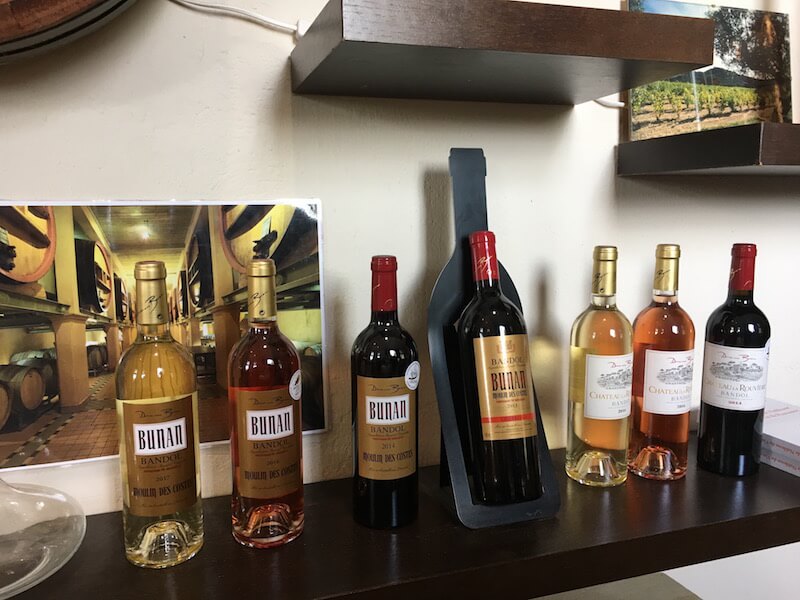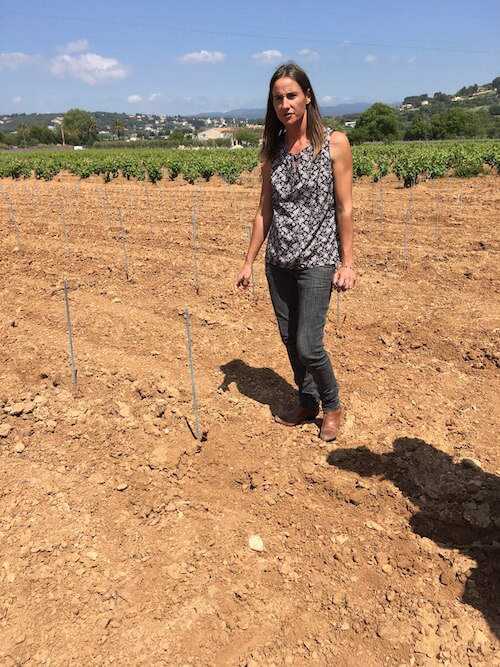 The town of Bandol is on the coast, but the appellation name derives from its role as the exporting point, rather than where the vineyards are. The vineyards are slightly inland and we learnt the fascinating story of the setting up of the appellation from Richard de Wahl Rubin, who Domaines Bunan had asked to present to our group.
The town of Bandol is on the coast, but the appellation name derives from its role as the exporting point, rather than where the vineyards are. The vineyards are slightly inland and we learnt the fascinating story of the setting up of the appellation from Richard de Wahl Rubin, who Domaines Bunan had asked to present to our group.
According to Richard (I’m covering myself here), the AOC Bandol was created by the German occupying army during the war, who mandated that olive groves should be replaced with vines (largely because that’s what the Romans had done), and set up a set of bizarre restrictions and requirements that a Brexiteer (which I am not) might claim perfectly caricatures both French and German nationalities. Bandol wines must be grown in the specific area, made from a minimum of 50% Mourvèdre grapes for reds and 50% Clairette for whites, from vines that are at least 12 years old, grown on hillsides, matured for at least 18 months in French oak mega-barrels (see below). Richard was the source of many other interesting stories, of varying degress of tall-ness, and I would recommend anyone finding themselves in Bandol making contact with him to find out more – see the bottom of this post.
After this rather scary start I was relieved to discover that I really like Bandol wines!
Domaines Bunan combines the wines of two brothers. Our visit was to Moulin de Coste, the winery of Paul Bunan, whose vineyards are on chalky east facing slopes, while brother Pierre’s Château de la Rouvière’s vineyards could be viewed across the valley, on south facing clay. This gave us a fantastic opportunity to experience the impact of contrasting terroirs. 
 Our tour of the winery, which is built on a slope to ensure gravity does some of the work of moving grapes and wine around, ending in the barrel cellar with the huge oak casks, holding thousands of litres of wine, above our heads – the complexity of renewing or replacing these monsters is amazing. We moved into the tasting room, where we compared the two estates’ whites, rosés and reds, from the 2016 and 2017 vintages.
Our tour of the winery, which is built on a slope to ensure gravity does some of the work of moving grapes and wine around, ending in the barrel cellar with the huge oak casks, holding thousands of litres of wine, above our heads – the complexity of renewing or replacing these monsters is amazing. We moved into the tasting room, where we compared the two estates’ whites, rosés and reds, from the 2016 and 2017 vintages.
 The chalky character of Moulin de Coste was most prominent in the whites, both made from predominantly Clairette, with Bourboulenc and Ugni Blanc in different proportions – more herbacous and structured than Chateau de la Rouvière which had more citrus fruit and was somewhat softer.
The chalky character of Moulin de Coste was most prominent in the whites, both made from predominantly Clairette, with Bourboulenc and Ugni Blanc in different proportions – more herbacous and structured than Chateau de la Rouvière which had more citrus fruit and was somewhat softer.
Of the two rosés (both much darker than the ones we had been drinking yesterday), the Rouvière with 60% Mourvèdre was richer and spicier, while the Moulin de Costes with 30% Mourvèdre and equal proportions of Grenache and Cinsault was more restrained.
 The reds both had great structure, ripe fruit and approachable tannins – the benefit of the 2 years Bunan reds spend in barrel. Mourvèdre was the predominant variety in all wines (as per the AOC rules), with Grenache and Cinsault in the Rouvière and Grenache and Syrah in the Moulin de Costes. They definitely need time to breath – so I may need to finesse my new policy of looking for Bandol red instead of Rioja on a restaurant wine list to find a good value wine with a great balance between ripe tannin and fruit!
The reds both had great structure, ripe fruit and approachable tannins – the benefit of the 2 years Bunan reds spend in barrel. Mourvèdre was the predominant variety in all wines (as per the AOC rules), with Grenache and Cinsault in the Rouvière and Grenache and Syrah in the Moulin de Costes. They definitely need time to breath – so I may need to finesse my new policy of looking for Bandol red instead of Rioja on a restaurant wine list to find a good value wine with a great balance between ripe tannin and fruit!
We finished with Moulin de Costes Charriage 2014 – 99% Mourvèdre, 5% Syrah was definitely big, with a lovely berry/vegetal nose, and a lot of tannin – needs some more time in bottle I feel.

 Lunch was at the Hostellerie Bérard, in the pretty hilltop town of La Cadière d’Azur, and was a perfect example of a high quality two course light lunch – rolled guinea fowl (described as shoulder but I’m sure birds don’t have shoulders!) on a potato ‘mille-feuille’ with a delicious jus (or gravy depending on where you are from), followed by a trio of sorbets, accompanied by a super Bandol rosé.
Lunch was at the Hostellerie Bérard, in the pretty hilltop town of La Cadière d’Azur, and was a perfect example of a high quality two course light lunch – rolled guinea fowl (described as shoulder but I’m sure birds don’t have shoulders!) on a potato ‘mille-feuille’ with a delicious jus (or gravy depending on where you are from), followed by a trio of sorbets, accompanied by a super Bandol rosé.

 In the afternoon we visited Domaine de l’Estagnol, a long established family winery now run by the sixth generation, Sandrine Ferraud, who took over from her mum, Hélène, in 2013. We were immediately taken to the vineyard to meet the newest arrivals – Mourvèdre vines that had been planted the day before. Sandrine elegantly but graphically described the work to get these bare-rooted plants into the ground and watered, and the care she would be giving them over the coming weeks. She had had to commence the paperwork to plant them a year before – and this vineyard is not even in the Bandol AOC!
In the afternoon we visited Domaine de l’Estagnol, a long established family winery now run by the sixth generation, Sandrine Ferraud, who took over from her mum, Hélène, in 2013. We were immediately taken to the vineyard to meet the newest arrivals – Mourvèdre vines that had been planted the day before. Sandrine elegantly but graphically described the work to get these bare-rooted plants into the ground and watered, and the care she would be giving them over the coming weeks. She had had to commence the paperwork to plant them a year before – and this vineyard is not even in the Bandol AOC!
Estagnol is a much smaller winery than Bunan, with 6 hectares of vines (2 of them planted in the last couple of years). The winery is in their Côte de Provence vineyard, they also have an AOC Bandol vineyard 30 minutes up the road by tractor!
 Sandrine described the harvest, done by hand (by Italian pickers), and in the tiny winery, on the site of an old olive oil mill, where we negotiated a maze of stainless steel, cement and ceramic tanks and oak barrels, she took us through vinifcation – until two harvests ago she was still using the old wood press to make red wine! She now uses a pneumatic press for all the wines, the reds take three weeks to ferment with lots of work to keep the wine moving and in contact with skins, and Bandol wine goes into oak for 18 months.
Sandrine described the harvest, done by hand (by Italian pickers), and in the tiny winery, on the site of an old olive oil mill, where we negotiated a maze of stainless steel, cement and ceramic tanks and oak barrels, she took us through vinifcation – until two harvests ago she was still using the old wood press to make red wine! She now uses a pneumatic press for all the wines, the reds take three weeks to ferment with lots of work to keep the wine moving and in contact with skins, and Bandol wine goes into oak for 18 months.

In the tiny tasting room, with locals popping in to buy the odd bottle or case, we tasted a lovely fresh Còtes du Provence white, Cuvée des Fidèles, a Bandol rosé, La Cabanon d’Hélène made by the seignée method, juice taken early during fermentation from Mourvèdre wine before too much colour is extracted, blended with Grenache and Cinsault, which was pale, delicate with a rich mouthfeel.
Finally we compared a 2014 vintages with a 2008 vintage of her Bandol red- a fine demonstration of how this wine can evolve to develop elegant farmyardy notes, but retain its fruit and tannin.
We thanked Sandrine, and Ahmed our super safe coach driver took us back to Aix, and bade us farewell. Our final outing was to Le Pigonnet, a very grand country house hotel now well inside the city of Aix, where we drank fizz in the garden and enjoyed a lovely, final night meal consisting of gravadlax on parmesan tuilles, perfectly medium rare beef and a chocolate mousse – washed down of course with rosé (and white and red). The weather held for us, and even this morning the threatening rain has not arrived so I’m out to explore Aix before we head for the airport at 2pm.
Provence delivered, as Tim said it would, a revelation of fantastic quality wine in a region that is largely ignored for is wine. If you haven’t got plans for early June, I would thoroughly recommend you contact Tim about the repeat of this tour which is running from 6th-10th June. And if that timing doesn’t work, but you find yourself in Provence, why not give Richard’s Bandol Wine Tours a go?
Fliss Syrad is Tim’s wife.
